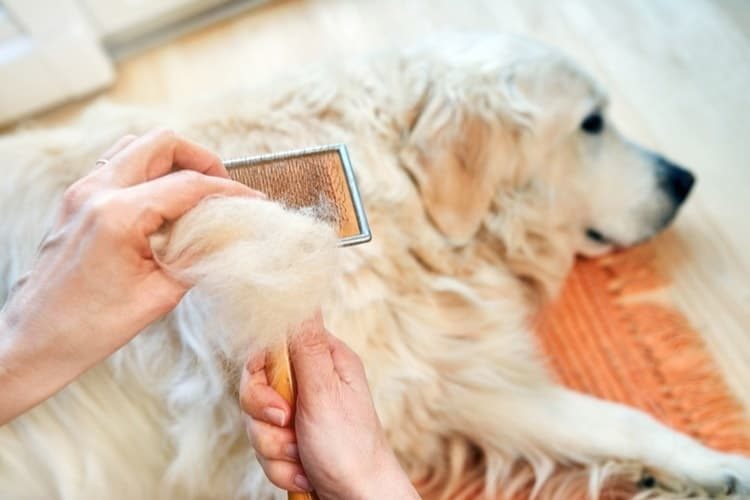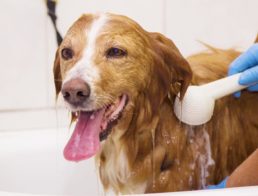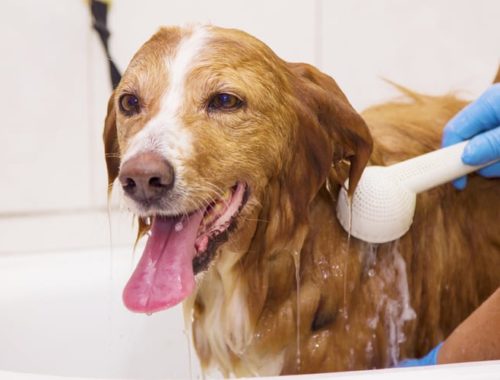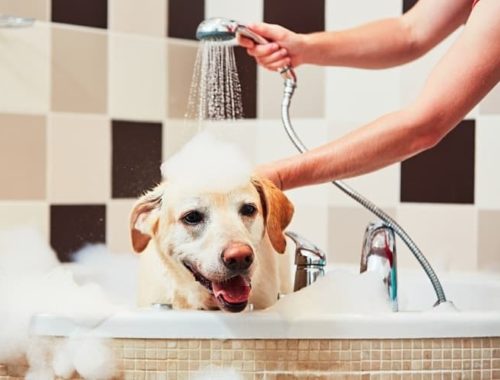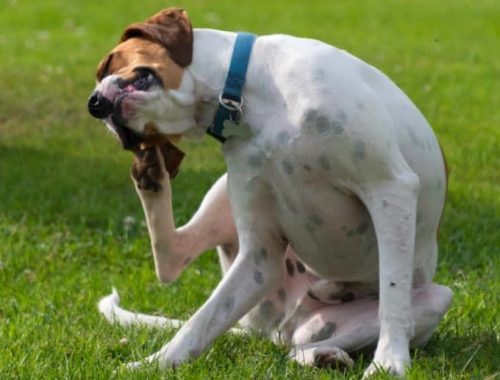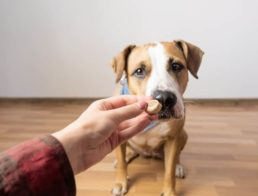It’s important to note there are several different reasons for a dog shedding. The most common, and unavoidable one, is the change in season. Your dog gets a thicker coat in the colder months to protect him from the elements, and he sheds that excess in the spring to prepare for warmer temperatures. Other reasons may be unhealthy skin and coat, allergies, stress, or other, more pressing concerns. All of these reasons should be considered, but if your dog is shedding in the normal cycle, there’s not a lot to do about preventing it, but you can manage it.
6 Simple Steps to De-Shed a Dog
1. Brush, Brush, Brush 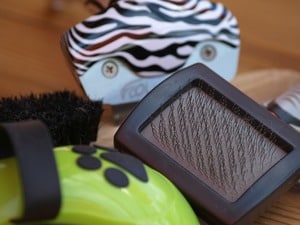
The fastest way to prevent shedding is to get rid of excess hair before it has the opportunity to fall off. If you wait for it to get bad, you may find you can pull hair off in clumps of fur, but to get ahead of the shedding, grab a good brush that will pull those clumps off in a much more efficient way.
If your pup is one that doesn’t love being brushed, then you may benefit from a shedding glove. With a glove that acts to pull out the loose and shedding hair, all you need to do is essentially pet him often, which will only strengthen your bond and build his trust (and which, in turn, may make detangling and baths easier in the future).
2. Bathe Your Dog Often
For a dog that sheds heavily, you will want to bathe him at least twice a month. Brush him before the bath to avoid clogging your drain. Some shampoos are actually designed to help with excessive shedding, so look for a shedding formulation. Don’t skip the conditioning step during a bath, particularly for shedding dogs, as it will help with damaged skin. You can double up on detangler and conditioner to make things easier on both you and him.
You may also want to consider blow drying your pup after his bath, too, but brush him while he’s wet so that you won’t have to pull as hard to eliminate any tangles. As long as your dog isn’t too bothered by the blow dryer, it can help speed up the process and help prevent tangled fur. You can also try a dog cage dryer instead, if the blow dryer is too intense for your dog.
3. Brush Again
Yes, brushing – again. This time, though, we’re talking about brushing your dog after he’s bathed and dry. You may find drying him will tangle his hair, and then not only will he shed, but he’ll shed in knotted clumps. So instead of just hair all over your furniture, you’ll find tumbleweeds of hair blowing all over your hardwood or tile floors.
4. Trim Your Dog’s Hair
If you find yourself a bit too busy to brush him as much as you’d like (or you just want to minimize all the upkeep), then maybe a more long-term solution for your pup is a nice haircut. That could mean once every couple of months you spend a Sunday afternoon washing, brushing, and trimming down his hair, or, if you don’t have the time for that either, taking him to a groomer may be your best bet. Keep in mind that even though you may only need to do if a handful of times each year, during the spring you’ll likely be taking him every couple weeks.
You can take your pooch to a big name store like PetSmart and expect to pay around $100 for a large dog to be washed and cut, or you can shop around and see if your local groomer has a better deal. If you choose to trim him yourself, there are plenty of high-quality dog grooming clippers and sets with a variety of grooming tools. Check out our list of the Best Dog Grooming Clippers to find the right option for your dog’s grooming needs.
The good news is that the more often you clip your dog, the better you’ll get and the faster the process will go.
5. Ensure Your Dog is Getting Healthy Nutrition
Just like with humans, sometimes hair loss is an indicator of an unhealthy diet. To avoid extra shedding, you’ll want to make sure your dog is as healthy as he can be. That means making sure he’s getting enough exercise and also making sure he’s eating right. If you prefer to feed your four-legged friend a natural or organic diet, check out our list of the Best Organic Dog Foods to find the right nutritious choice for your dog.
If you know his food is a quality one that promotes a healthy diet, then you may want to go the extra mile by buying some supplements that can benefit his coat. Fish oils are rich in omega-3, which will help the health of your dog’s skin and coat and minimize his shedding. You can purchase an oil to go directly onto his food each meal, or you can get pills that he can take each day as treats.
6. Talk To Your Vet
There may be some options that are specific to your dog or your home, location, or situation that general guidelines and tips don’t address. Before you take any drastic measures, you’ll want to talk to your vet, naturally. If your dog’s shedding isn’t improved by the above options, you may find there’s something bigger at play. Some other cause may be negatively affecting your dog’s health and simply manifesting through drastic shedding. Besides seasonal shedding, more common causes of shedding include allergies, parasites, and infections. All of these are problems that need to be addressed by your vet.
Taking care of a dog that sheds can certainly seem like a never-ending task. Just remember that when you decided to love and care for your dog, part of the deal was that you’ll take care of the things his little paws can’t. And that means you get to be his hair stylist, too.
Featured Image Credit: sonsart, Shutterstock


